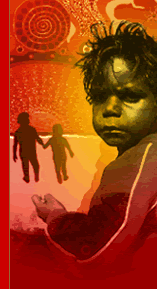

|
|
||
Briefing PapersSNAICC Briefing paper - Statistics on Indigenous Family Violence, Child Abuse and Child Neglect2002 Indigenous children represent nearly half (48%) of the Aboriginal & Torres Strait Islander population (ABS 1998). 15% of Aboriginal and Torres Strait Islander children are under five years of age - more than twice as many as the non-Indigenous population with only 7% under five (ABS 1998). Aboriginal and Torres Strait Islander children experience higher rates of child abuse and child neglect than non-Indigenous children (AIHW 2001). Approximately 3,000 Aboriginal and Torres Strait Islander children are found to have been abused or neglected each year (AIHW 2001). Aboriginal and Torres Strait Islander children are six times more likely to be removed from their families by welfare authorities than non-Indigenous children because of child abuse or child neglect (AIHW 2000). Child neglect, (often associated with poverty, poor housing and unemployment), is the major reason for Indigenous children being removed from their families, not child abuse. (SNAICC 2001). Twice as many Aboriginal and Torres Strait Islander child are removed from their families because of child neglect than child abuse (SNAICC 2001). Child sexual assault happens to boys and girls. 1 in 4 girls and 1 in 9 boys are likely to be sexually assaulted before they reach the age of 18. In some Aboriginal and Torres Strait Islander communities the rate of child sexual assault is likely to be higher (FYCCQ, 2000). Over 85% of abused children are harmed by someone they know and trust - a parent, caregiver, family member or friend (FYCCQ, 2000). In NSW, Aboriginal & Torres Strait Islander children make up over 25% of all children in the care and protection system despite comprising less than 2% of the total population of children aged 0 - 17 (AIHW 2000). In Victoria, Indigenous children comprise 10% of children in care and less than 1% of the population aged 0-17 (AIHW 2000). Aborigines are more than 45 times more likely to be a victim of family violence than non-Aborigines. (Ferrante A, Morgan F, Indermaur D. & Harding R, 1996) Family violence impacts seriously on the physical, emotional and general health and development of a child. Babies and toddlers are especially at risk from the damaging effects of family violence (James, M. 1994) Young Indigenous women are 15 times more likely to be hospitalised due to violence than other young women whilst young Indigenous men are 2.7 times more likely to be hospitalised from violence than other young men. (AIHW 1999) Every community is affected by family violence, child abuse and child neglect Every community leader has a responsibility to do all that they can to protect children from abuse or violence and to respond to children's needs if they have been abused or harmed or are at risk of being abused or harmed. References: ABS (1998). 1996 Census of Population and Housing - Aboriginal and Torres Strait Islander People. Australian Bureau of Statistics (ABS), Canberra. AIHW (1998). Child Protection Australia 1996-97. Australian Institute of Health and Welfare, AIHW, Canberra. AIHW (2000). Child Protection Australia 1998-1999. Australian Institute of Health and Welfare, (AIHW), Canberra. AIHW (2001). Child Protection Australia 1999-2000. Australian Institute of Health and Welfare, (AIHW), Canberra. James, Marianne. (1994). Domestic violence as a form of child abuse: Identification and prevention. Issues in Child Abuse Prevention (No.1). National Child Protection Cleartinghouse. Australian Institute of Family Studies, AIFS. Melbourne. Ferrante A, Morgan F, Indermaur D. & Harding R. (1996) Measuring the Extent of Domestic Violence. Hawkins Press. Sydney. FYCCQ (2000). Child Abuse Prevention Public Speaking Kit. Office of Child Protection, Families, Youth and Community Care Queensland, FYCCQ. Brisbane. SNAICC (1996). Proposed Plan of Action for the Prevention of Child Abuse and Neglect in Aboriginal Communities. Australian Government Publishing Service, AGPS, Canberra. SNAICC (2002). Their Future - Our Responsibility. Secretariat of National Aboriginal and Islander Child Care. Melbourne.
|
||
